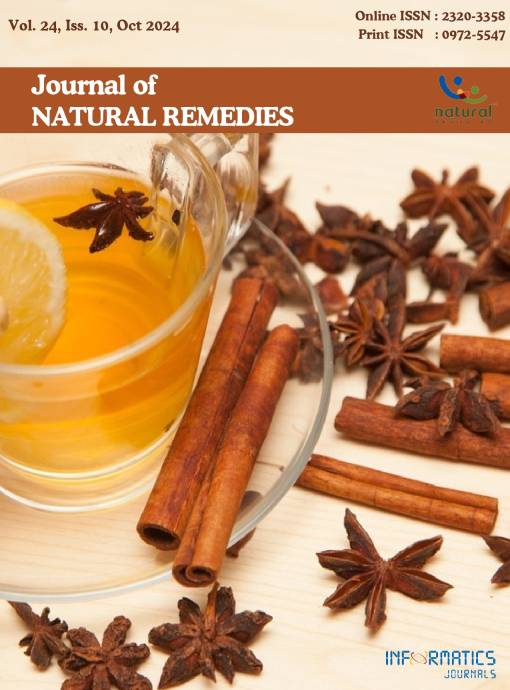Formulation Development and Evaluation of Film Liquid Bandage Using Gallic Acid for Wound Healing
DOI:
https://doi.org/10.18311/jnr/2024/43800Keywords:
Gallic Acid, In Vitro Skin Permeation, Liquid-Bandage, Retention Study and Wound HealingAbstract
Background: Wound healing is a complex process requiring optimal tissue repair and regeneration conditions. Liquid bandages (L-bandages) offer an innovative approach to wound care by forming a protective film over wounds, aiding healing and preventing infections. Gallic Acid (GA), known for its anti-inflammatory, antibacterial, and antioxidant properties, is a promising natural agent for wound healing. Aim: This study aims to develop and evaluate a film-forming L- bandage incorporating GA for effective wound healing. Methods: Various formulations were prepared using film-forming agents such as xanthan gum, pectin gum and polyvinyl pyrrolidone, with GA as the active ingredient. The formulations were evaluated for physical properties, including pH, viscosity, drying time and film characteristics such as flexibility, washability, and stickiness. In vitro studies were conducted to assess skin permeation and drug retention. Results: The optimised formulation demonstrated desirable physical properties, including a pH of 5.6, appropriate viscosity and rapid drying time. The film was flexible, easily washable and exhibited minimal stickiness. In vitro permeation studies showed effective skin penetration and retention of GA, indicating its potential for sustained therapeutic action. Conclusion: The GA-based L- bandage showed promising results as a wound healing agent, offering a natural, effective solution for protecting and treating superficial skin injuries. The formulation’s favourable physical properties and drug delivery potential support its use as an innovative wound care product. Further studies are warranted to confirm its efficacy in clinical settings.
Downloads
Metrics
Downloads
Published
How to Cite
Issue
Section
License
Copyright (c) 2024 Sapna Desai, Snehal Patel, Himanshu Panchal, Divyang Patel, Jhanvi Sethi, Hardi Shah, Dhananjay Meshram (Author)

This work is licensed under a Creative Commons Attribution 4.0 International License.
Accepted 2024-08-13
Published 2024-11-06
References
Kaplani K, Koutsi S, Armenis V, Skondra FG, Karantzelis N, Tsaniras CS, et al. Wound healing related agents: Ongoing research and perspectives. Adv Drug Deliv Rev. 2018; 129:242-53. https://doi.org/10.1016/j.addr.2018.02.007 PMid: 29501699.
Eming SA, Martin P, Tomic-Canic M. Wound repair and regeneration: Mechanisms, signalling and translation. Sci Transl Med. 2014; 6(265):265sr6. https://doi.org/10.1126/scitranslmed.3009337 PMid:25473038 PMCid: PMC49 73620.
Rodrigues M, Kosaric N, Bonham CA, Gurtner GC. Wound healing: A cellular perspective. Physiol Rev. 2019; 99(1):665706. https://doi.org/10.1152/physrev.00067.2017 PMid:30 475656 PMCid: PMC6442927.
Bryan N, Ahswin H, Smart N, Bayon Y, Wohlert S, Hunt J. Reactive oxygen species (ROS)- A family of fate deciding molecules pivotal in constructive inflammation and wound healing. Eur Cell Mater. 2012; 24(249):e65. https://doi.org/10.22203/eCM.v024a18 PMid:23007910.
Checa J, Aran JM. Reactive oxygen species: Drivers of physiological and pathological processes. J Inflamm Res. 2020; 13:1057-73. https://doi.org/10.2147/JIR.S275595 PMid:33293849 PMCid: PMC7719303.
Bansal P, Verma S, Khan W, Kumar N. Global patent and technological status of biodegradable polymers in drug delivery and tissue engineering. In: Biodegradable polymers in clinical use and clinical development. Hoboken, NJ, USA: John Wiley and Sons, Inc.; 2011; 665725. https://doi.org/10.1002/9781118015810.ch18
Bai J, Zhang Y, Tang C, Hou Y, Ai X, Chen X, et al. Gallic acid: Pharmacological activities and molecular mechanisms involved in inflammation-related diseases. Biomed Pharmacother. 2021; 133(110985):110985. https://doi.org/10.1016/j.biopha.2020.110985 PMid:33212373.
Saifullah Q, Sharma A, Kabra A, Alshammari A, Albekairi TH, Alharbi M, et al. Development and optimization of film forming non-pressurized liquid bandage for wound healing by Box-Behnken statistical design. Saudi Pharm J. 2023; 31(12):101864. https://doi.org/10.1016/j.jsps.2023.101864 PMid:38028211 PMCid: PMC10663907.
Guinovart T, Valdés-Ramírez G, Windmiller JR, Andrade FJ, Wang J. Bandage-based wearable potentiometric sensor for monitoring wound pH. Electroanalysis. 2014; 26(6):1345-53. https://doi.org/10.1002/elan.201300558
Poologasundarampillai G, Wang D, Li S, Nakamura J, Bradley R, Lee PD, et al. Cotton-wool-like bioactive glasses for bone regeneration. Acta Biomater. 2014; 10(8):3733-46. https://doi.org/10.1016/j.actbio.2014.05.020 PMid:24874 652.
Scarpa M. Defining end-user acceptability attributes of orodispersible films for patient centricity: UCL (University College London); 2019.
Frederiksen K, Guy RH, Petersson KJ. Formulation considerations in the design of topical, polymeric filmforming systems for sustained drug delivery to the skin. Eur J Pharm Biopharm. 2015; 91:9-15. https://doi.org/10.1016/j.ejpb.2015.01.002 PMid:25595740.
Berthomieu C, Hienerwadel R. Fourier transform infrared (FTIR) spectroscopy. Photosynth Res. 2009; 101(2-3):15770. https://doi.org/10.1007/s11120-009-9439-x PMid:1951 3810.
Kumar PS, Raj NM, Praveen G, Chennazhi KP, Nair SV, Jayakumar R. In vitro and in vivo evaluation of microporous chitosan hydrogel/ nanofibrin composite bandage for skin tissue regeneration. Tissue Eng Part A. 2013; 19:380-92. https://doi.org/10.1089/ten.tea.2012.0376 PMid:22934717 PMCid: PMC3542877.
Chaturvedi S, Garg A. An insight of techniques for the assessment of permeation flux across the skin for optimization of topical and transdermal drug delivery systems. J Drug Deliv Sci Technol. 2021; 62(102355):102355. https://doi.org/10.1016/j.jddst.2021.102355

 Sapna Desai
Sapna Desai









 0.35
0.35 24
24 0.161
0.161